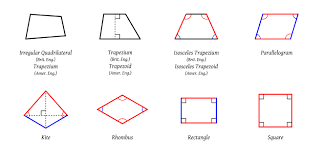Math 2 Reviewer
Quadrilaterals
a four-sided polygon

Parallelogram
a quadrilateral with 2 pairs of parallel sides.

Rhombus
has 4 congruent sides

Rectangle
has 4 right angles

Square
has both 4 congruent angles and 4 right angles

Quadrilateral Angle-Sum Theorem
the sum of the measures of the interior angles of a quadrilateral is 360 degrees

Properties of Parallelograms
if a quadrilateral satisfies any of the conditions, then it is a parallelogram
1) Both pairs of opposite sides are parallel
2) Both pairs of opposite sides are congruent
3) Both pairs of opposite angles are congruent
4) The consecutive angles are supplementary
5) A pair of opposite sides are both parallel and congruent
6) The diagonals bisect each other
7) Each diagonal divides a parallelogram into 2 congruent triangles
Special Parallelograms
Rectangle
the diagonals of a rectangle are congruent
Rhombus
the diagonals of a rhombus are perpendicular
Square
the diagonals of a square are both congruent and perpendicular
TRAPEZOIDS
a quadrilateral with a pair of parallel sides
Theorem 1:
the median of a trapezoid is parallel to its bases, and its length is half the sum of the length of the bases
Isosceles Trapezoid
a trapezoid with congruent legs
Theorem 2:
the base angles of an isosceles trapezoid are congruent
Theorem 3:
the diagonals of an isosceles trapezoid are congruent
Midline theorem(Triangles Only)
the midline(midsegment) of a triangle is parallel to the base of the triangle and its length is half as long as the base
KITE
a quadrilateral with 2 pairs of adjacent sides that are congruent, and no opposite sides are congruent
consecutive sights with equal length.
Theorem 1:
the diagonals of a kite are perpendicular
Theorem 2:
a kite has exactly one pair of opposite angles that are congruent
Theorem 3:
the diagonal through the vertex angles(angles up&down) bisects the vertex angles(angles left&right) and the other diagonal

Solving
Pythagoream theorem
ax²+b²=c²Use to identify diagonal’s measurements.
Median Formula
b1+b2/2 = median